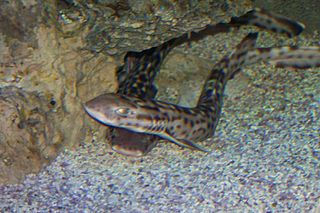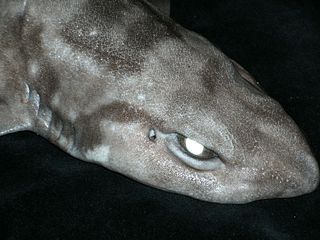
Carcharhiniformes, the ground sharks, are the largest order of sharks, with over 270 species. They include a number of common types, such as catsharks, swellsharks, and requiem sharks.

Catsharks are ground sharks of the family Scyliorhinidae. They are the largest family of sharks with around 160 species placed in 17 genera. Although they are generally known as catsharks, some species can also be called dogfish due to previous naming. However, a dogfish may generally be distinguished from a catshark as catsharks lay eggs while dogfish have live young. Like most bottom feeders, catsharks feed on benthic invertebrates and smaller fish. They are not harmful to humans. The family is paraphyletic, containing several distinct lineages that do not form a monophyletic group.

Scyliorhinus is a genus of catsharks in the family Scyliorhinidae. This genus is known in the fossil records from the Cretaceous period, late Albian age to the Pliocene epoch.

The redspotted catshark, also known as the Chilean catshark, is a species of catshark commonly found in the coastal waters of the southeastern Pacific, from central Peru to southern Chile. They are typically found in the rocky sublittoral areas at the edge of the continental shelf, in waters down to 100 m in depth. They spend the spring, summer, and fall in rocky subtidal areas, but winter in deeper offshore waters due to the strong currents at that time of year.

Apristurus is a genus of catsharks, the family Pentanchidae, the deepwater catsharks. The species in this genus are commonly known as the ghost or demon catsharks.

Atelomycterus is a genus of coloured catsharks in the family Atelomycteridae.
Aulohalaelurus is a genus of coloured catsharks in the family Atelomycteridae.

Galeus is a genus of catshark, belonging to the family Scyliorhinidae, commonly known as sawtail catsharks in reference to a distinctive saw-toothed crest of enlarged dermal denticles, found along the upper edges of their caudal fins. They are found in the Atlantic, the western and central Pacific, and the Gulf of California, inhabiting deep waters at or close to the sea floor. Members of this genus are rather small, slim sharks with firm bodies and thick, rough skin. Their heads are usually fairly long and pointed, and have large mouths with well-developed furrows at the corners. They have large pectoral and anal fins, and two similar dorsal fins placed well back. Many species are ornately patterned with dark saddles and/or blotches. Sawtail catsharks feed on various invertebrates and fishes, and may be either egg-laying or live-bearing. These harmless sharks are sometimes caught as bycatch but are of minimal commercial value.

The Australian marbled catshark is a coloured catshark of the family Atelomycteridae, found in the eastern Indian Ocean, endemic to Western Australia between latitudes 12 and 21°S, from the surface to 245 m (800 ft) deep. Its length is up to 60.0 cm, and it typically inhabits coastal waters with sandy or rocky bottoms.

The Bali catshark is a species of coloured catshark, belonging to the family Atelomycteridae, found only off the Indonesian island of Bali. It can grow up to 47 cm (19 in). Atelomycterus baliensis inhabits the deep coastal waters of Bali, Indonesia, feeding on small fish and invertebrates.

The narrowmouthed catshark is a coloured catshark beloning to the family Atelomycteridae, found from central Chile around the Straits of Magellan, to Argentina between latitudes 23° S and 56° S, at depths down to about 180 m (600 ft) in the Atlantic Ocean and about 360 m (1,200 ft) in the Pacific. It can grow to a length of up to 70 cm (28 in). The reproduction of this catshark is oviparous.

The narrowtail catshark is a catshark of the family Scyliorhinidae, found off the coasts of Honduras and Nicaragua, between latitudes 18° N and 10° N, at depths between 190 and 410 m. It can grow up to a length of 35 cm (14 in). The reproduction of this catshark is oviparous.
The lizard catshark is a small shark species of the catshark family, Scyliorhinidae, found off the coast of southern Brazil on the upper continental shelf at depths of between 250 and 500 metres.

The slender catshark is a small species of catshark belonging to the family Scyliorhinidae. It is found on the upper continental slope off the coast of Suriname, French Guiana and northern Brazil, including the mouth of the Amazon River at depths between 72 and 450 metres. Its it can grow up to a length of 70 centimetres (28 in).

The longfin sawtail catshark is a rare, little-known species of catshark, part of the family Scyliorhinidae. Once thought to be a subspecies of the roughtail catshark along with the Antilles catshark, it inhabits deep water off the Caribbean coasts of Panama and Colombia. This slim-bodied species has a marbled dorsal color pattern and a prominent crest of enlarged dermal denticles along the dorsal edge of its caudal fin. It can be distinguished from similar species by its relatively longer anal fin and small adult length of under 35 cm (14 in). The longfin sawtail catshark is oviparous.

Scyliorhinus meadi, the blotched catshark, is a little-known species of catshark, and part of the family Scyliorhinidae, found in the western central Atlantic Ocean. It inhabits banks of deep-sea coral at depths of 329–548 m (1,079–1,798 ft), feeding on cephalopods, shrimp, and bony fishes. This species can be identified by its wide body and head, and the dark saddle-like markings on its back. It also has small spots that fluoresce yellow under a blue light. Adult blotched catsharks have not been observed; the largest immature specimen is 49 cm (19 in) long. Like other catsharks, it is believed to be oviparous. This species is not dangerous to humans and has no commercial significance.
William Charles Schroeder (1895–1977) was an American ichthyologist. He was born on Staten Island, New York. He, along with his lifelong colleague Henry Bryant Bigelow, made substantial contributions to the knowledge of the fish fauna of the western North Atlantic. The two described 42 new species of jawless fishes and cartilaginous fishes, and authored several seminal publications, including Fishes of the Western North Atlantic and Fishes of the Gulf of Maine.

Atelomycteridae, the coloured catsharks, is a family of sharks belonging to the order Carcharhiniformes. These sharks are found in the Indian, Pacific and Western Atlantic Oceans.














